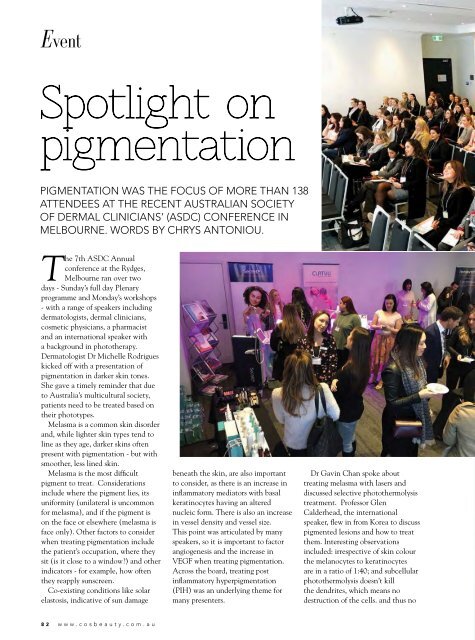CosBeauty Magazine #81
CosBeauty is the #BeautyAddict's guide to lifestyle, health and beauty in Australia. In this issue we look at: • Essential Exfoliation - Smooth Skin for Spring • Why your Beauty Sleep is really important • 40 over 40 - Anti-ageing must have products • Tassie Road Trip • Lauren Hannaford - FHIT for Life • Face Value - Facial Surgeries explained
CosBeauty is the #BeautyAddict's guide to lifestyle, health and beauty in Australia. In this issue we look at:
• Essential Exfoliation - Smooth Skin for Spring
• Why your Beauty Sleep is really important
• 40 over 40 - Anti-ageing must have products
• Tassie Road Trip
• Lauren Hannaford - FHIT for Life
• Face Value - Facial Surgeries explained
You also want an ePaper? Increase the reach of your titles
YUMPU automatically turns print PDFs into web optimized ePapers that Google loves.
Event<br />
Spotlight on<br />
pigmentation<br />
Pigmentation was the focus of more than 138<br />
attendees at the recent australian society<br />
of dermal clinicians’ (ASDC) conference in<br />
melbourne. words by Chrys Antoniou.<br />
The 7th ASDC Annual<br />
conference at the Rydges,<br />
Melbourne ran over two<br />
days - Sunday’s full day Plenary<br />
programme and Monday’s workshops<br />
- with a range of speakers including<br />
dermatologists, dermal clinicians,<br />
cosmetic physicians, a pharmacist<br />
and an international speaker with<br />
a background in phototherapy.<br />
Dermatologist Dr Michelle Rodrigues<br />
kicked off with a presentation of<br />
pigmentation in darker skin tones.<br />
She gave a timely reminder that due<br />
to Australia’s multicultural society,<br />
patients need to be treated based on<br />
their phototypes.<br />
Melasma is a common skin disorder<br />
and, while lighter skin types tend to<br />
line as they age, darker skins often<br />
present with pigmentation - but with<br />
smoother, less lined skin.<br />
Melasma is the most difficult<br />
pigment to treat. Considerations<br />
include where the pigment lies, its<br />
uniformity (unilateral is uncommon<br />
for melasma), and if the pigment is<br />
on the face or elsewhere (melasma is<br />
face only). Other factors to consider<br />
when treating pigmentation include<br />
the patient’s occupation, where they<br />
sit (is it close to a window?) and other<br />
indicators - for example, how often<br />
they reapply sunscreen.<br />
Co-existing conditions like solar<br />
elastosis, indicative of sun damage<br />
beneath the skin, are also important<br />
to consider, as there is an increase in<br />
inflammatory mediators with basal<br />
keratinocytes having an altered<br />
nucleic form. There is also an increase<br />
in vessel density and vessel size.<br />
This point was articulated by many<br />
speakers, so it is important to factor<br />
angiogenesis and the increase in<br />
VEGF when treating pigmentation.<br />
Across the board, treating post<br />
inflammatory hyperpigmentation<br />
(PIH) was an underlying theme for<br />
many presenters.<br />
Dr Gavin Chan spoke about<br />
treating melasma with lasers and<br />
discussed selective photothermolysis<br />
treatment. Professor Glen<br />
Calderhead, the international<br />
speaker, flew in from Korea to discuss<br />
pigmented lesions and how to treat<br />
them. Interesting observations<br />
included: irrespective of skin colour<br />
the melanocytes to keratinocytes<br />
are in a ratio of 1:40; and subcellular<br />
photothermolysis doesn’t kill<br />
the dendrites, which means no<br />
destruction of the cells. and thus no<br />
82 www.cosbeauty.com.au

















